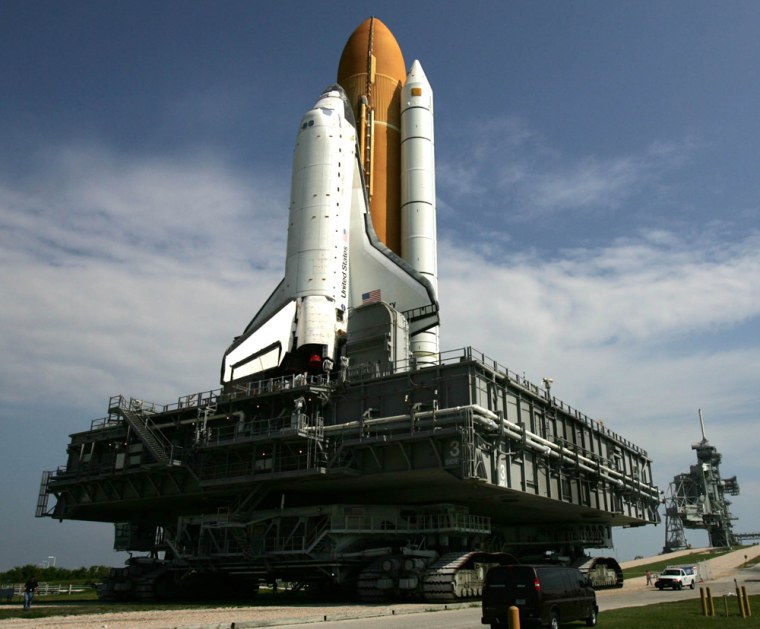A panel overseeing NASA’s resumption of shuttle flights concluded Monday that the space agency has failed to meet the toughest safety recommendations put in place after the Columbia disaster.
Despite exhaustive work and considerable progress over the past 2 1/2 years, NASA has been unable to eliminate the possibility of dangerous pieces of foam and ice from breaking off the external fuel tank and striking the shuttle at liftoff, the return-to-flight task force said.
In addition, NASA still does not have a clear idea of all the potential threats from ice, and still lacks a practical way to fix holes and other damage caused by flyaway launch debris, the group said.
It was not immediately clear if NASA would further delay the shuttle launch in light of the task force’s recommendations. In a statement following Monday’s meeting, agency Administrator Michael Griffin said he welcomed different points of view and that he expected “a healthy debate” in this week’s flight review by NASA.
Monday’s findings came after a deliberate and prolonged discussion by the 26-member task force marked by some dissent. It was the group’s last public meeting, and the chairman said he would present a summary report to NASA before its leaders gather later this week to discuss shuttle readiness and set a formal launch date for Discovery.
NASA has been aiming for a liftoff of Discovery as early as July 13 on the first mission since Columbia’s destruction during re-entry on Feb. 1, 2003.
Task force chairman Richard Covey, a former astronaut, stressed that the three recommendations debated Monday represented the most technically challenging of the 15 put forth by Columbia accident investigators as being essential for the resumption of shuttle flights.
The task force found in previous sessions that NASA has complied with those 12 other recommendations considered essential for the resumption of shuttle flights.
While NASA has come up with good techniques for inspecting the shuttle in orbit, it does not meet the intent of the Columbia investigators’ recommendation for having the capability to make emergency repairs in space, the task force said. The space agency has also put off long-term improvements to the shuttle’s thermal shielding because of the fleet’s planned retirement in 2010, making full compliance with the recommendations impossible in some cases, members noted.
Task force member Joseph Cuzzupoli, a Kistler Aerospace Corp. vice president, said NASA got a fast and early start in understanding the foam-loss problem, and minimized and reduced the amount that can come off. Unfortunately, he noted, the problem of ice building up on the tank once filled with super-chilled fuel was tackled late — just a few months ago.
“Foam is characterized pretty good,” Cuzzupoli said at a news conference later in the day. “The ice story is still coming together.”
Concern over ice prompted NASA, in the spring, to delay Discovery’s flight to the international space station from May to July.
NASA to make own determination
Griffin has insisted for weeks that he and his top managers will have the final say on when and whether it’s safe to resume shuttle launches, regardless of what advisory groups like the task force have to say.
Covey said Griffin will take the task force’s independent advice and use it to determine whether it’s safe for shuttles to fly.
“Quite honestly, we were trying to stay away from being someone who gave a thumbs-up or a thumbs-down on whether it’s OK to fly. We weren’t going to do that,” Covey said.
He added, “Is it a miss if you’re at 95 percent? ... We haven’t seen anything that says the progress they’ve made is of concern, relative to the safety of the vehicle.”
Covey was pressed by reporters whether he personally thought it was safe for NASA to launch Discovery in July. He declined to answer specifically but said that if he were younger and on flight status, he would have no concern about flying aboard Discovery.
Task force member James Adamson, another former astronaut, said it is NASA’s job — not the task force’s — to determine whether the risks are acceptable and whether it’s safe for Discovery to fly.
He noted, however, that he did not believe that the risks could be reduced significantly even if NASA were to postpone the launch from July to September, the next available launch window.
A suitcase-size chunk of insulating foam came off Columbia’s external fuel tank during liftoff in January 2003 and carved a hole in the left wing that let in deadly atmospheric gases during re-entry two weeks later. All seven astronauts aboard were killed.
